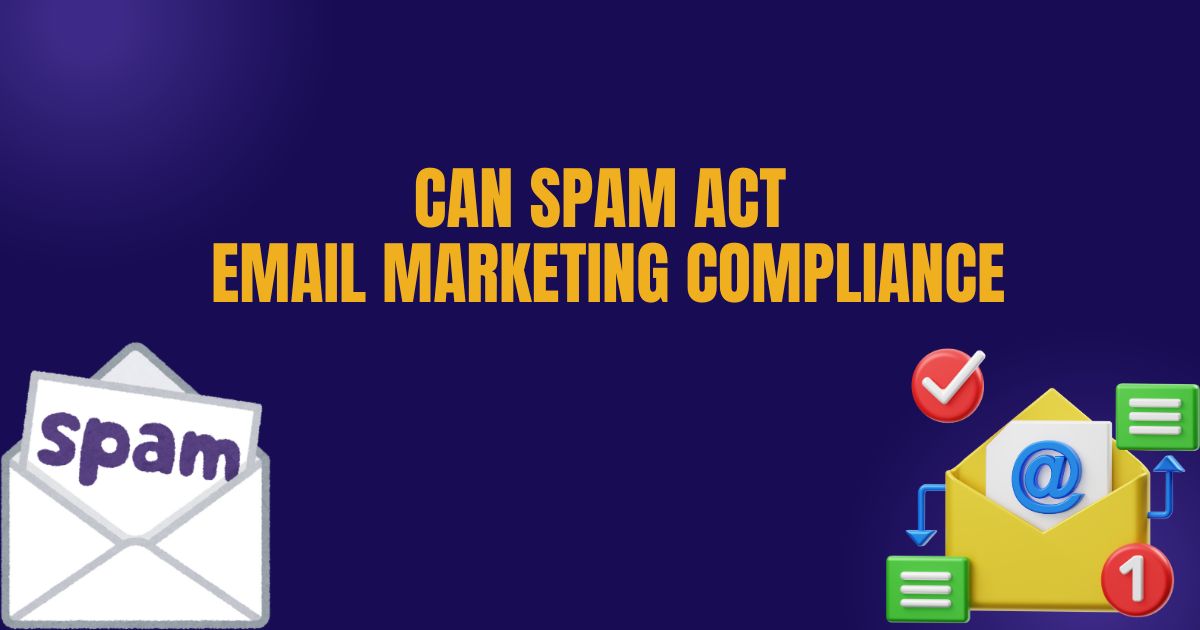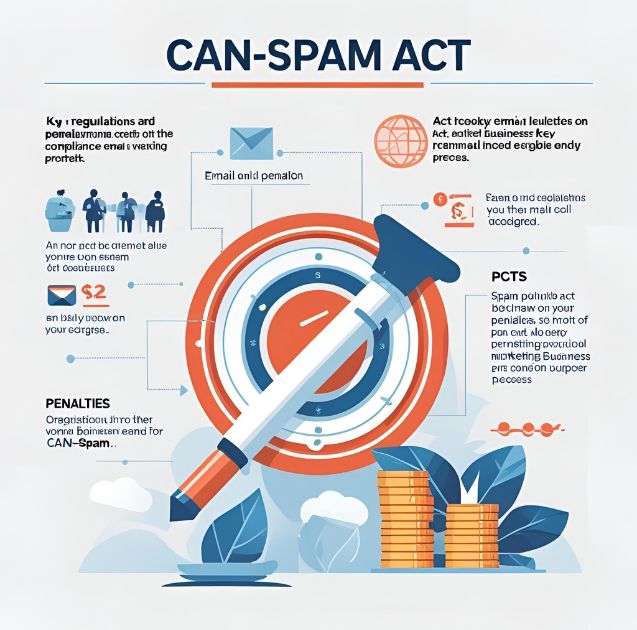
Email marketing remains one of the most effective digital marketing channels, delivering an average ROI of $42 for every dollar spent. However, this powerful tool comes with important legal responsibilities. The Controlling the Assault of Non-Solicited Pornography and Marketing (CAN-SPAM) Act sets the rules for commercial email in the United States, and violations can result in penalties of up to $51,744 per email.
Understanding and following CAN-SPAM requirements isn’t just about avoiding fines—it’s about building trust with your audience and maintaining a strong sender reputation. This comprehensive guide will walk you through everything you need to know about CAN-SPAM Act compliance, from basic requirements to best practices that will keep your email marketing campaigns both legal and effective.
What is the CAN-SPAM Act?

The CAN-SPAM Act became law in 2003 as a response to the growing problem of unsolicited commercial email. Enforced by the Federal Trade Commission (FTC), this legislation establishes national standards for sending commercial email messages and gives recipients the right to stop receiving emails from your business.
The law applies to all commercial messages, which the FTC defines as any electronic mail message where the primary purpose is advertising or promoting a commercial product or service. This includes email sent to businesses as well as consumers, making it relevant for both B2B and B2C email marketing campaigns.
Unlike some international regulations that require explicit consent before sending marketing emails, CAN-SPAM follows an “opt-out” model. This means you can send commercial emails to recipients without prior permission, but you must provide a clear way for them to unsubscribe and honor those requests promptly.
The Seven Key Requirements of CAN-SPAM
Don’t Use False or Misleading Header Information
Your “From,” “To,” “Reply-To,” and routing information must be accurate and identify the person or business who initiated the message. This means you cannot use fake sender names, misleading domain names, or forge email headers to disguise the origin of your message.
For example, if your company is “ABC Marketing,” you cannot send emails that appear to come from “XYZ Corporation” or use a fake reply-to address. The header information should clearly and truthfully identify your business as the sender.
Don’t Use Deceptive Subject Lines
Your subject line must accurately reflect the content of your message. You cannot use misleading or false information to trick recipients into opening your emails. Subject lines like “Urgent: Your Account Will Be Closed” for a promotional email about a sale would violate this requirement.
Keep your subject lines honest and relevant to your email content. If you’re promoting a discount, say so. If you’re sharing a newsletter, make that clear. Transparency in subject lines not only keeps you compliant but also builds trust with your audience.
Identify the Message as an Advertisement
Commercial emails must be clearly identified as advertisements. While the law doesn’t specify exactly how to do this, common approaches include adding “Advertisement” or “Ad” to the subject line or including a clear statement within the email body.
Many businesses satisfy this requirement by including phrases like “This is a commercial email” or “Advertisement” in a prominent location within their email template.
Tell Recipients Where You’re Located
Every commercial email must include your valid physical postal address. This can be your current street address, a post office box registered with the U.S. Postal Service, or a private mailbox registered with a commercial mail receiving agency established under Postal Service regulations.
This requirement applies even if you operate an online-only business. The address should be clearly visible in your email, typically in the footer section.
Tell Recipients How to Opt Out
You must provide a clear and conspicuous way for recipients to unsubscribe from your emails. This typically means including an unsubscribe link that’s easy to find and use. The opt-out mechanism should be functional for at least 30 days after you send your message.
Your unsubscribe process should be simple and straightforward. Recipients shouldn’t have to provide additional information beyond their email address or jump through multiple hoops to stop receiving your emails.
Honor Opt-Out Requests Promptly
Once someone asks to unsubscribe, you have 10 business days to process their request. You cannot charge a fee, require additional information beyond an email address, or make the recipient take any steps other than sending a reply email or visiting a single webpage to complete the opt-out process.
After someone opts out, you cannot sell or transfer their email address to another company, even if the recipient doesn’t specifically ask you not to do so.
Monitor What Others Are Doing on Your Behalf
If you hire another company to handle your email marketing, you’re still legally responsible for compliance. This means you need to ensure that any third-party email service providers, marketing agencies, or partners follow CAN-SPAM requirements when sending emails on your behalf.
Who Must Comply with CAN-SPAM?
The CAN-SPAM Act applies broadly to commercial email senders. You must comply if you send commercial emails that either originate in the United States or are sent to recipients with U.S. email addresses, regardless of where your business is located.
This includes businesses of all sizes, from solo entrepreneurs to large corporations. Whether you send 10 emails or 10 million, the same rules apply. The law covers various types of commercial communications, including promotional emails, newsletters with commercial content, and transactional emails that contain advertising material.
Even if you only occasionally send marketing emails, you still need to follow CAN-SPAM requirements. The law doesn’t provide exemptions based on email volume, business size, or industry type.
Penalties for Non-Compliance
CAN-SPAM violations can be costly. The FTC can impose civil penalties of up to $51,744 per email that violates the law. For businesses sending thousands of emails, this can quickly add up to millions of dollars in potential fines.
Beyond FTC enforcement, the law also allows internet service providers to sue for damages. Some states have additional email marketing laws that may impose additional penalties. Criminal penalties, including imprisonment, may apply for the most serious violations, such as using false header information or harvesting email addresses.
These penalties underscore the importance of taking CAN-SPAM compliance seriously. The cost of implementing proper compliance measures is minimal compared to the potential financial and reputational damage of violations.
Best Practices for CAN-SPAM Compliance
Use Double Opt-In When Possible
While CAN-SPAM doesn’t require prior consent, implementing a double opt-in process can help ensure you’re sending emails to engaged recipients who actually want to hear from you. This practice involves sending a confirmation email when someone subscribes and requiring them to click a link to confirm their subscription.
Double opt-in helps reduce spam complaints, improves deliverability, and creates a more engaged subscriber base. It also provides clear evidence that recipients consented to receive your emails.
Keep Detailed Records
Maintain records of when and how people subscribed to your emails, along with documentation of your compliance measures. This information can be valuable if questions arise about your email practices or if you need to demonstrate compliance during an investigation.
Your records should include subscription dates, IP addresses, source pages, and any confirmation emails sent. Many email service providers automatically maintain these records for you.
Regularly Clean Your Email List

Remove bounced email addresses, honor unsubscribe requests promptly, and consider implementing a re-engagement campaign for inactive subscribers. A clean, engaged email list not only helps with compliance but also improves your deliverability and campaign performance.
Regular list maintenance helps you avoid sending emails to non-existent addresses or recipients who are no longer interested in your content.
Train Your Team
Ensure everyone involved in your email marketing understands CAN-SPAM requirements. This includes employees who create email content, manage subscriber lists, or work with third-party email service providers.
Regular training helps prevent accidental violations and ensures consistent compliance across your organization.
Protecting Your Email Marketing Investment
CAN-SPAM compliance isn’t just about following the law—it’s about building sustainable, effective email marketing campaigns. By following these requirements and implementing best practices, you’ll create stronger relationships with your subscribers, improve your email deliverability, and protect your business from costly penalties.
Start by auditing your current email practices against CAN-SPAM requirements. Review recent email campaigns, check your unsubscribe process, and ensure your email templates include all required information. If you work with third-party providers, verify their compliance procedures and consider adding CAN-SPAM requirements to your contracts.
Remember that email marketing regulations continue to evolve, and staying informed about changes will help you maintain compliance while maximizing the effectiveness of your campaigns. Consider consulting with a legal professional if you have specific questions about how CAN-SPAM applies to your business or industry.


















No Comments